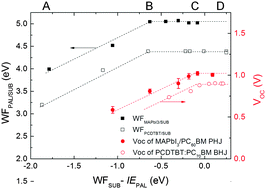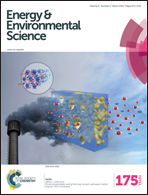Universal energy level tailoring of self-organized hole extraction layers in organic solar cells and organic–inorganic hybrid perovskite solar cells†
Abstract
Tailoring the interface energetics between a polymeric hole extraction layer (HEL) and a photoactive layer (PAL) in organic photovoltaics (OPVs) and organic–inorganic hybrid perovskite solar cells (PrSCs) is very important to maximize open circuit voltage (Voc), power conversion efficiency (PCE), and device lifetime. In principle, when Fermi-level pinning and a vacuum level shift take place between the HEL and PAL, they give rise to an energy level offset between the HEL and the valence band maximum (VBM) (or the highly occupied molecular orbital (HOMO) in the case of organic photoactive materials) of the PAL and then Voc loss. However, here we show that the Voc loss at the interface can be overcome by universal energy level tailoring of a self-organized HEL (SOHEL) between the HEL and PAL irrespective of photoactive materials. A SOHEL composed of a conducting polymer and a perfluorinated ionomer (PFI) is effectively used to study the interface energetics in OPVs and PrSCs. We systematically tailored the interface energy level of the SOHEL to remove the energy offset at the interface and understand clearly the universal energy level alignment with the diverse photoactive materials of OPVs and PrSCs. The Fermi-level of the HEL is pinned to the midgap state of photoactive materials, which is about 0.6–0.7 eV above the VBM or HOMO. However, the interface energy state of the PFI-enriched surface layer of the SOHEL can be formed deeper below the Fermi-level by self-organized molecules so that it can match the top of the valence band of the photoactive materials. As a result, the energy offset at the interface between photoactive materials and the SOHEL can be significantly decreased to achieve high Voc and PCE. Furthermore, our SOHEL significantly prolonged the stability of OPVs (half lifetime: 2.84 year) compared with pristine PEDOT:PSS (half lifetime: 0.2 year) under continuous irradiation of air mass-1.5 global simulated sunlight at 100 mW cm−2 due to the diffusion-blocking ability of the self-organized PFI at the surface of SOHELs for impurities from indium tin oxide.



 Please wait while we load your content...
Please wait while we load your content...